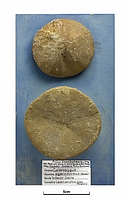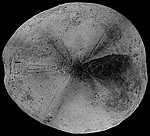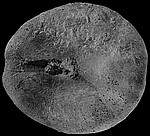Galeropygidae
Lambert, 1911, p.28
Genre type : Galeropygus Cotteau, 1856, p.648
Description succinte de la famille : Appareil apical tétrabasal, ambulacres simples

Diagnose originale de l'espèce par Wright,1852
On the Cassidulidae of the Oolites, with descriptions of some new species of that family, p.99
![]()
|
Hyboclypus agariciformis, Forbes, n. sp. Test disciform, subpentagonal, and mach depressed ; ambulacra narrow, the three anterior straight, the posterior pair sinuous ; interambulacra unequal and covered with an immense profusion of microscopie tubercles ; apical dise central and vertical ; anal valley deep with parallel sides, which gradually expand about the middle of the single interambulacrum ; mouth-opening small. Height 9/10ths of an inch, antero-posterior and transverse diameters 3 inches and 1/10th. One large specimen measures, in the antero-posterior and transverse diameters, 3 inches and 6/10ths. Descrtption.—The outline of this Urchin varies a little in different individuals ; in general the antero-posterior equals the transverse diameter, but sometimes the transverse exceeds the antero-posterior diameter. The ambulacra are of unequal width ; the single anterior ares is the narroweat, and the posterior pair are the widest ; each pair of ambulacral plates carry from four to six tubercles, which are so disposed that they foret oblique rows of from four to six in a row, which meet in the median line and branch upwards and outwards, forming thereby V-shaped figures. The pores are arranged closely together in pairs on the dorsal surface, but from the basal angle to the mouth they are set wider spart, and fall into triple oblique pairs. The interambulacral arete are of unequal width; the anterior pair measure at the circumference 1 inch and 5/10ths, the posterior pair 1 inch and 11/20ths ; the single ares is 1/10th of an inch wider than the posterior pair. The inequality in the width of these are causes the subpentagonal form of the test ; the interambulacral plates are slightly bent upwards at the middle, and their surface is covered with numerous small tubercles; in an ordinary-sized plate, I have counted 100 tubercles, each of which is perforated and surrounded by an areola. The base is flat and slightly undulated, in consequence of the ambulacra forming straight valleys, and the interambulacra couver conical lobes between the basal angle and the mouth. The oral opening is situated nearer the anterior than the posterior border; it is small, of a pentagonal form, and han the border surrounded by five small lobes formed by the termination of the interambulacral area ; the tubercles are large and more fully developed on the basal than on the dorsal surface of the test, and the ancolie are seau in this region to be merely the margina of the depressions in the centre of which the tubercles are placed. The apical dise is situated in the vertex and is nearly central ; the plates of which it was formed are absent in all the specimens I have seen ; the single and the anterior pair of ambulacre converge around its anterior border, and the posterior pair terminate about two lines from the latter at the posterior and external side of the disc. The single interambulacrum is somewhat wider and longer than the others ; the anal opening is situated in its dorsal part |
in a deep valley with parallel vertical aides covered with tubercles; about the middle of the opening, the valley expands and forms a concave depression in ita lower hall.; the basal portion of the area is slightly produced, and forma a lip-shaped process, which gives a considerable convexity and prominence to the basal angle of this area. Affinities and differences.—H. agaricifornsis differs so widely from its congeners in our Oolites that it cannot be mistaken for either of them ; its shield-shape and depressed vertex distinguish it from H. gibberulus, and its dimensions, circuler form, and rounded posterior border serve as diagnostic characters between it and H. caudatus. From Pygaster, with which form it has been erroneously grouped, it is diatinguished by the greater number and microscopie character of the tubercles in Hyboclypus, the deep anal valley with its parallel vertical walls, and the excentric five-lobed mouth ; whereas in Pygaster the tubercles are fewer and larger, the anal opening forma a large space without a valley and parallel walls, and the mouth is central, and has its margin divided into ten lobes like Holectypus and all the Cidaridae. Locality and stratigraphical range.—This species is tolerably abundant in the lower ferruginous beds, "the Pea-grit" of Leckhampton, Crickley, Birdlip, Coopera, and Cleeve Hills : as far as we at present know, it is not found in the middle division of the Oolites. History.—This species bas been elaborately figured for the 4th decade of Professor Forbes's 'Memoirs of the Geological Survey' from the specimens now before me, and will be described in detail in that work, to which I beg to refer for more ample particulars.
|
Syntype conservé au Sedgwick Museum of Earth Sciences, University of Cambridge
|
|
http://www.3d-fossils.ac.uk/fossilType.cfm?typSampleId=20006896crédit British Geological Survey, NERCspecimen SM J 34963 - J 34964 figuré in McCoy 1848, Annals and Magazine of Natural History n. ser. (2) ii p.413 |
|
|
|
|
Galeropygus agariciformis (Wright ,1852) - Aalénien, Sables de Tessé, Villaine la Carelle, Orne, 35 mm |
|
Galeropygus agariciformis (Wright ,1852) - Aalénien, Sarthe, 32 mm |
|
Galeropygus agariciformis (Wright ,1852) - Aalénien, Villaines la Carelle, Sarthe, 21 mm |

|
Classification méthodique et genera des échinides vivants et fossiles, p.53 Espèce type Hyboclypus caudatus Wright, 1852, par monotypie On the Cassidulidae of the oolites, with descriptions of some new species of that family, p.100 Extension stratigraphique (bibliographique, non vérifiée) : Bajocien - Bathonien Syn.
|
Diagnose originale du genre par Pomel
Classification méthodique et genera des échinides vivants et fossiles, p.53
|
Aulacopygus. Ovate, rétréci, déclive et ondulé en arrière. Apex un peu excentrique en avant, oblong, mais toutes les ocellaires petites logées dans les angles extérieurs ; les génitales antérieures plus petites, surtout celle de gauche ; une pièce supplémentaire centrale, suivie d'une seconde, qui pourrait être la 5eme génitale imperforée. Ambulacres simples. Péristome elliptique un peu |
anguleux ; périprocte étroit touchant à l'apex, au sommet d'un sillon profond caréné, s'évasant au pourtour. Granulation très fine. Hybo. caudatus, Wright, espèce typique, est jurassique |
![]()
le nom est considéré comme valide ici
Diagnose originale de l'espèce par Cotteau
Paléontologie française, terrains jurassiques, 1874, p.521
|
N°88 bis. Hyboclypeus sub-circularis, Cotteau, 1874. Pl.141, fig. 3-5, et pl.142, fig. 1-6. Espèce de taille moyenne, sub-circulaire, aussi large que longue, arrondie an avant, très-légèrement rostrée en arrière ; face supérieure uniformément bombée, déclive dans la région postérieure ; face inférieure concave, sub-pulvinéd. Somme ambulacraire sub-central, un peu rejeté en avant. Aires ambulacraires inégales ; les postérieures, moins longues, plus flexueuses et un peu plus larges que les autres, disparaissent à leur partie supérieure dans le sillon anal. Zones porifères composées de pores petits, arrondis, égaux entre eux, s'espaçant à la face inférieure, se multipliant un peu autour du péristome. Tubercules très-petits, épars, sub-scrobiculés, abondants à la face supérieure, plus gros et plus serrés dans la région infra-marginale, plus espacées et plus largement scrobiculés en se repprochant du péristome. Granules intermédiaires fins, abondants, homogènes, disposés en cercles autour des tubercules plus développés de la face inférieure. Péristome un peu excentrique en avant, sub-pentagonal, légèrement enfoncé. Périprocte ovale, peu étendu, situé dans un sillon profond, caréné sur le bord, qui part du sommet et se prolonge en s'évasant à peine jusqu'au bord postérieur. La partie antérieure de l'appareil apical est conservée dans un de nos exemplaires : la plaque madréporiforme et la plaque génitale antérieure de gauche se touchent par le milieu, et paraissent directement superposées aux autres plaques comme dans l'appareil des Hyboclypeus. Hauteur, 12 millimètres ; diamètre transversal, 26 millimètres ; diamètre antéro-postérieur, 25 millimètres et demi. Rapports et différences. - Cette espèce, en raison de sa forme sub-circulaire, présente la physionomie des Galeropygus et se rapproche du G. disculus, mais elle s'en distingue d'une manière positive par la structure allongée de son appareil apical, caractère qui la place parmi les Hyboclypeus, dans le voisinage de l'H. theobaldi ; elle diffère de cette dernière espèce par sa forme plus circulaire et moins sensiblement rostrée en arrière, par sa face inférieure plus concave et plus sensiblement pulvinée, par son sillon anal plus droit, plus caréné, moins évasé. |
Localité. - Nancy (Meurthe-et-Moselle). Très-rare. Etage bajocien. Ma collection. Explication des figures. - Pl.141, fig.3, H. sub-circularis, vu de côté, de ma collection ; fig.4, face inférieure ; fig.5, péristome grossi. - Pl.142, fig.1, autre exemplaire de l'H. sub-circularis, vu de côté, de ma collection ; fig.2, face supérieure ; fig.3, région anale ; fig.4, portion de la face supérieure grossie ; fig.5, tubercules de la face supérieure grossis ; fig.6, tubercules de la face inférieure grossis.
Planches 141 & 142 d'après Cotteau |
|
Aulacopygus subcircularis (Cotteau,1874) - aalénien, sarthe, 18mm |
|
Aulacopygus subcircularis (Cotteau,1874) - Aalénien, Neuvillalais, Sarthe, 17 mm |

![]()
|
Hyboclypus gibberulus Agassiz ,1839 |
Diagnose originale de l'espèce par Agassiz, 1839
Description des échinodermes fossiles de la Suisse, p.75
|
Hyboclypus gibberulus Ag. Tab. XII, fig. l 0-12. Vue d'en haut, cette espèce se fait remarquer au premier coup-d'œil , par une crête très-saillante de l'aire ambulacraire impaire, à la face supérieure; particularité qui lui a valu son nom. Au bord antérieur cette crête se transforme en un sillon assez profond, qui continue jusqu'à la bouche. Le sillon de l'aire interambulacraire impaire , dans lequel s'ouvre l'anus, commence tout près du sommet ; il est d'abord étroit et profond, puis s'évase de plus en plus pour disparaître complètement au bord postérieur. L'ouverture anale elle-même est située au fond du sillon. Le côté antérieur est beaucoup plus rétréci que le côté postérieur, qui est tronqué et bien moins élevé. Les ambulacres sont visibles depuis l'appareil oviducal jusqu'à la bouche; mais, passé le milieu de la circonférence, les paires de pores sont moins rapprochées qu'à la face supérieure. L'appareil oviducal lui-même n'est pas conservé dans les exemplaires que j'ai sous les yeux ; mais l'on peut conclure de la convergence des ambulacres, qu'il n'occupait pas un bien grand espace. Le test est mince et recouvert, sur toute sa surface , de tubercules homogènes , à la manière des Echinolampes. Je ne connais que deux exemplaires de cette espèce ; ils font partie de la collection du Musée de Carlsruhe ; l'étiquette indique comme origine la Suisse et comme gisement le terrain jurassique. Ils ont en effet tout-àfait l'apparence de fossiles jurassiques de l'oolithe ferrugineuse. Planche XIII |
|
|
http://coldb.mnhn.fr/catalognumber/mnhn/f/j01633 spécimen MNHN.F.J01633 crédit RECOLNAT (ANR-11-INBS-0004) Peter MASSICARD Kier, p. 27 pl. 1 fig. 6 et 7 text-fig. 4 et 5 |
|
|
|
|
Hyboclypus gibberulus Agassiz ,1839 - Oxfordien moyen, Ardennes, 41 mm |
|
Hyboclypus gibberulus Agassiz ,1839 - Callovien, Sarthe, 51 mm |




,%20apical,%20Aalenien,%20Vilaine%20la%20Carelle,%20Sarthe,%2021%20mm.jpg)


,%20oral,%20Aalénien,%20Neuvillalais,%20Sarthe,%2017%20mm.jpg)





